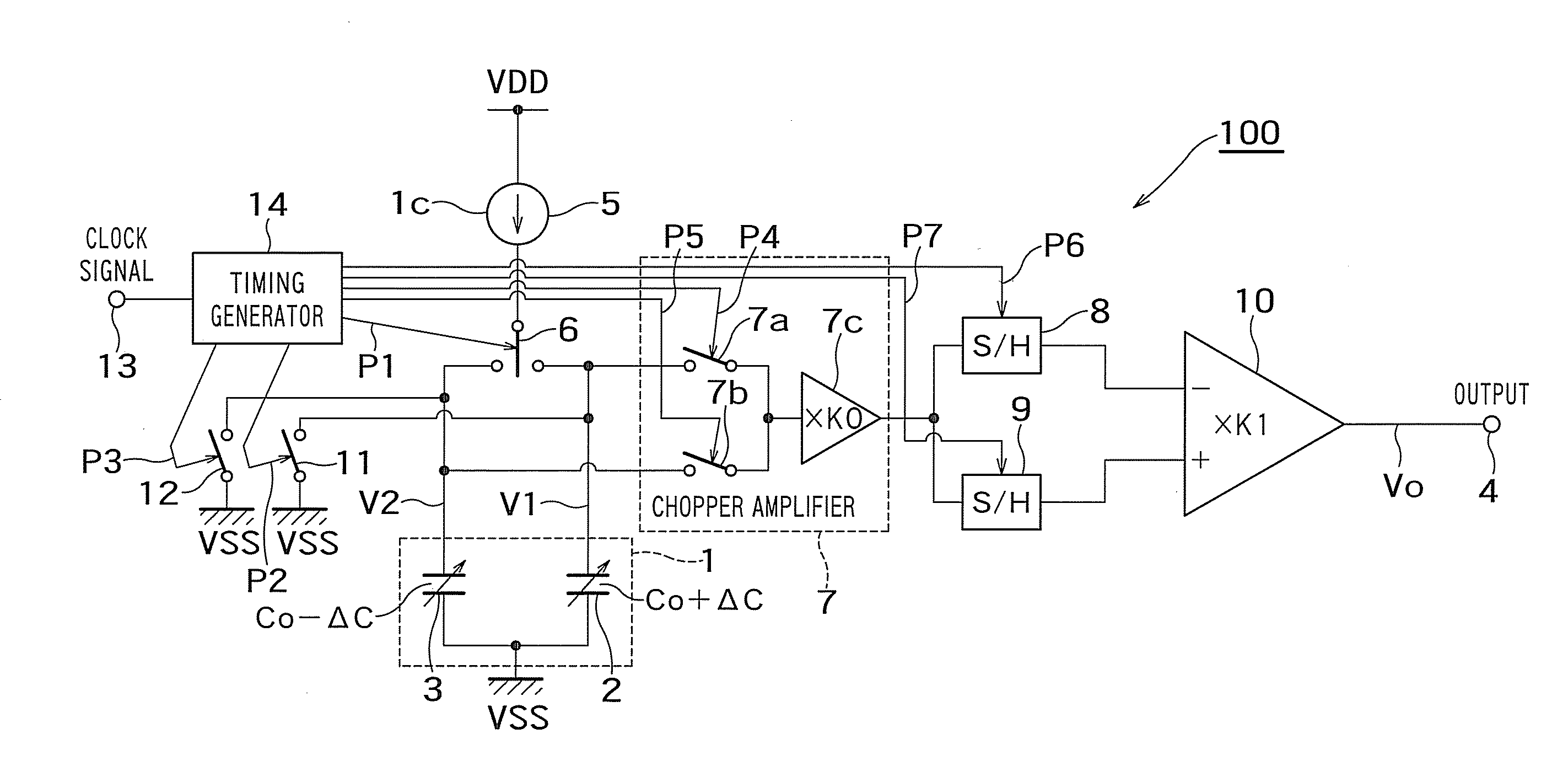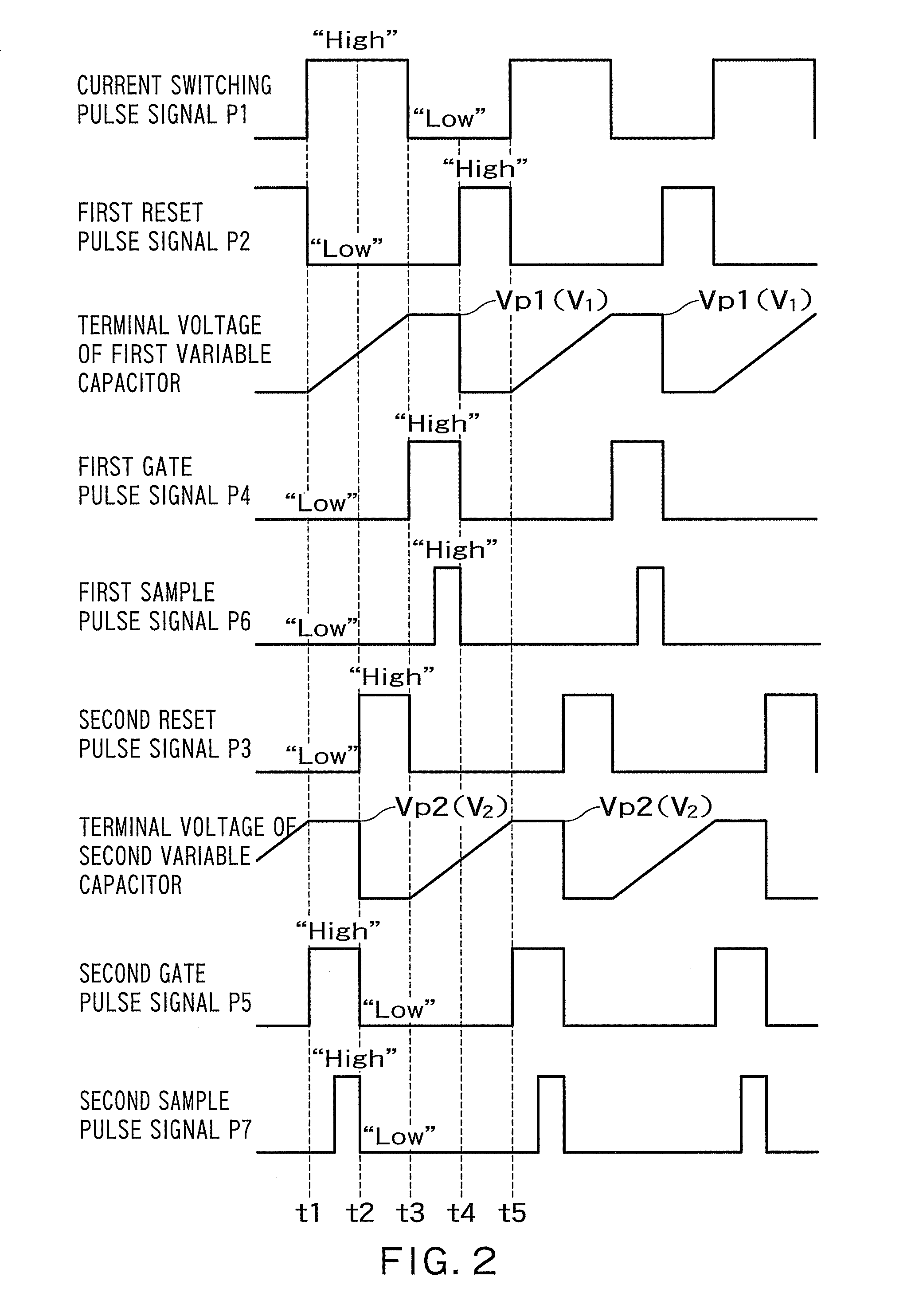Capacitance difference detecting circuit
a detection circuit and capacitance technology, applied in capacitance measurement, resistance/reactance/impedence, instruments, etc., can solve the problems of long wiring between the sensor and the inverter input terminal, high power consumption, complex structure,
- Summary
- Abstract
- Description
- Claims
- Application Information
AI Technical Summary
Benefits of technology
Problems solved by technology
Method used
Image
Examples
embodiment 1
[0068]FIG. 1 is a diagram showing a configuration of essential parts of a capacitance difference detecting circuit according to an embodiment 1, which is an aspect of the present invention.
[0069]As shown in FIG. 1, a capacitance difference detecting circuit 100 detects the voltages for charging a first variable capacitor 2 and a second variable capacitor 3 forming a MEMS sensor 1, the sum of the capacitances of which is constant. The capacitance difference detecting circuit 100 outputs a signal corresponding to the detected voltages to an output terminal 4.
[0070]The capacitance difference detecting circuit 100 has a current source 5 that supplies a charging current to the first and second variable capacitors 2 and 3, and a current switching circuit 6 that is connected between the current source 5 and the first and second variable capacitors 2 and 3.
[0071]In this example, the current source 5 is a constant current source.
[0072]The current switching circuit 6 performs a switching oper...
embodiment 2
[0108]In the embodiment 1 described above, the current source that supplies a current to the variable capacitors is a constant current source.
[0109]In an embodiment 2, there will be described a configuration in which the current from the current source is adjusted so that the output of the capacitance difference detecting circuit is equal to a constant reference value.
[0110]FIG. 3 is a diagram showing a configuration of essential parts of a capacitance difference detecting circuit according to the embodiment 2, which is an aspect of the present invention. In this drawing, the same reference numerals as those in the embodiment 1 shown in FIG. 1 denote the same components as those in the embodiment 1.
[0111]As shown in FIG. 3, compared with the embodiment 1, a capacitance difference detecting circuit 200 further has a control amplifier 15 that sums the output of a first sampling and holding circuit 8 and the output of a second sampling and holding circuit 9, amplifies the sum value by ...
embodiment 3
[0120]In the embodiment 2, there has been described a configuration in which the current from the current source is adjusted so that the output of the capacitance difference detecting circuit is equal to a constant reference value.
[0121]In an embodiment 3, there will be described another configuration in which the current from the current source is adjusted so that the output of the capacitance difference detecting circuit is equal to a constant reference value.
[0122]FIG. 4 is a diagram showing a configuration of essential parts of a capacitance difference detecting circuit according to the embodiment 3, which is an aspect of the present invention. In FIG. 4, the components of a capacitance difference detecting circuit 300 other than those corresponding to the first and second sampling and holding circuits, the operational amplifier circuit and the control amplifier in the embodiment 2 shown in FIG. 3, which are different from those in the embodiment 2 shown in FIG. 3, are omitted b...
PUM
 Login to View More
Login to View More Abstract
Description
Claims
Application Information
 Login to View More
Login to View More - R&D
- Intellectual Property
- Life Sciences
- Materials
- Tech Scout
- Unparalleled Data Quality
- Higher Quality Content
- 60% Fewer Hallucinations
Browse by: Latest US Patents, China's latest patents, Technical Efficacy Thesaurus, Application Domain, Technology Topic, Popular Technical Reports.
© 2025 PatSnap. All rights reserved.Legal|Privacy policy|Modern Slavery Act Transparency Statement|Sitemap|About US| Contact US: help@patsnap.com



